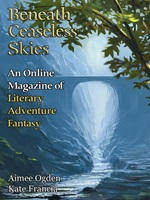 Beneath Ceaseless Skies #441, September 18, 2025
Beneath Ceaseless Skies #441, September 18, 2025
“The Nature of Spells, the Nature of Children” by Aimee Ogden
“Holly on the Mantel, Blood on the Hearth” by Kate Francia
Reviewed by Axylus
“The Nature of Spells, the Nature of Children” by Aimee Ogden is a retelling of the classic fairy tale “Beauty and the Beast.” In this account there’s no Beauty, only grim substitutes, and the tale is considerably darker and more true to life than anything Disney ever hawked. The story focuses on the daily lives and trials of the servants who have been transformed into household objects, and in particular on the teapot, Jeanne-Marie.
It is difficult for me to frame my response to this story, because there’s nothing wrong with anything on its pages; in fact, aside from a couple of tiny quibbles, the text is certainly more than satisfying. The problem is my considerable frustration that an implicit contract between the author and reader has been broken at my expense. The story, in my mind at least, ends even before reaching its proper midpoint. Jeanne-Marie experiences a sea-change in her perception of her situation, and she makes the decisive leap from a reactive stance to an active one in the face of the brutish behavior of the Beast. At that point, the story closes with the abruptness of a slamming door.
In standard structure, there would be more space to explore the new reality flowing from Jeanne-Marie’s epiphany, and her change toward actively engaging the Beast would fall somewhere at or near the story’s midpoint. Of course the author can begin or end her tale anywhere, at her own discretion. But there is a simple reason why the standard structure is standard: it allows room for the full emotional experience that arises from the realization that conflict will occur, then the conflict itself, as well as an up and down between success and failure, a tug and pull between a desire to make changes in life and a desire to retreat to the familiar but unsatisfying prior status quo. There is however scant emotional build up and no emotional payoff in this short story, plus no conflict, no plot progression after the initial turning point, and no climax. I feel cheated of a full tale, like taking a seat at a restaurant expecting a steak dinner, but receiving a large, white plate with a sprig of parsley in its center. A moral dilemma arises for me, then: do I judge solely by the words on the page, or by my very negative reaction to the truncated length? After wrestling with my conscience, I choose the latter. It coulda been something, coulda been so much better.
“Holly on the Mantel, Blood on the Hearth” by Kate Francia is another tale that leaves me wondering how to react. Don’t get me wrong. The writing is rich and descriptive, and the premise pleasingly distinct from standard fantasy fare. Without giving away too much, the protagonist, a young and recently-married Anglo-Saxon pagan woman named Hereswith, has suffered devastating loss, and is very far from any emotional recovery. After seeing the gruesome result of the village men’s hunting party, she encounters an otherworldly and potentially dangerous wight in the wilds, and makes a telling decision.
Once again, there is no conflict to etch the protagonist’s choices in sharper relief, or to push the reader to root for her more emphatically. This to me is the story’s biggest flaw. Had her discovery of the wight been framed as happening while the men were hunting, rather than after, there would have been opportunities for conflicting goals, for the reader to choose sides, and for Hereswith’s choices to accrue more urgency and salience.
A second shortcoming is that the beginning is a relatively long, slow burn that threatens to become tedious. There is a somewhat frantic and bloody event near the outset of the tale, but this adds no emotional propulsion to the plot, principally because its relation to other events and themes is not particularly clear. Perhaps it was intended as a vivid concrete event that encapsulates and communicates the bitter gap between the surface flow of events and Hereswith’s genuine reality, as in for example the all-too-familiar bloody bucket scene from the Stephen King horror novel Carrie. If so, it failed to land: the protagonist neither caused nor suffered from the mishap. Finally, Norse disir spirits are discussed somewhat at length, but have no impact on events, or resonance with any theme.
My second major reservation about this story is that I never experienced any emotions while reading. The author repeatedly informed me that the protagonist felt this or felt that, but alas, the descriptions never hit home. Some might counter that the tale’s lack of emotional resonance for me stems from the fact that I am male, and both the author and protagonist are female. Fair enough, but at least within a reader-centric literary culture and tradition, it is the author’s responsibility to bridge that perception gap, to use literary devices that make the protagonist’s pain real and emotionally accessible to all. In my humble opinion, this tale could have benefited additionally from a heightened emotional reaction to the aforementioned bloody mishap (or some other event that offers a jolt of energy and emotion), as well as a far tighter and more evocative link between it and later events, and Hereswith’s perceptions of herself and her world.